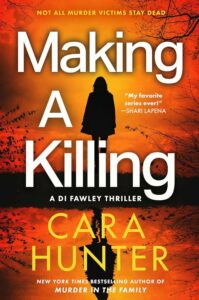DI Adam Fawley #7
 If you haven’t read the first book in this series, Close to Home, please, read no further. Instead, go find a copy, and get as hooked on DI Adam Fawley as I am. Then, get caught up (it will only take a couple of days, I guarantee it) and dive into this one. Fawley is a detective in Oxford, England, and author Hunter supplies a character list at the beginning of each book, golden age style. It is helpful, as there are a lot of characters, and while the police characters are important, in Hunter’s universe, story is all. So pull up a seat.
If you haven’t read the first book in this series, Close to Home, please, read no further. Instead, go find a copy, and get as hooked on DI Adam Fawley as I am. Then, get caught up (it will only take a couple of days, I guarantee it) and dive into this one. Fawley is a detective in Oxford, England, and author Hunter supplies a character list at the beginning of each book, golden age style. It is helpful, as there are a lot of characters, and while the police characters are important, in Hunter’s universe, story is all. So pull up a seat.
***SPOILERS BELOW FOR BOOK ONE***
The police ranks will be familiar to any reader of British crime novels or avid viewers of Britbox detective shows, but the storytelling here, while certainly utilizing traditional tropes and thriller-y twists you might find in a Harlan Coben novel, is pure 21st century. Hunter uses emails, newspaper clippings, photos, social media posts and text messages to tell her story. At times it feels like you are the detective as she makes you work a bit to parse out the story from her plethora of facts. I loved this, and it reminded me of Minette Walters, who wrote some stunning books in the 90’s utilizing a similar method (one of which Hunter refers to in the text).
The story follows the one in Close to Home, which was about the disappearance of 8 year old Daisy Mason. Daisy had disappeared from an end of school year party and her mother ultimately was jailed for murder. As this novel opens, a body is discovered. There’s a hair on it – not the corpse’s – which turns out to be a match to little Daisy, who would now be sixteen years old. The detectives are gob smacked, to say the least, and the team who investigated the case, led by Fawley, is reassembled. Daisy and whoever she was with appear to have vanished from the face of the earth, and what’s more, the police have no idea who the dead woman is that has been discovered.
As they attempt to backtrack and reinvestigate their case, they reach out to all the central characters in the drama: Daisy’s parents and her brother, her classmates and teachers. They begin to find small things they missed but they still aren’t getting the complete picture. The reader is more fortunate as we are allowed access to Daisy’s online diary. This along with other things they begin to discover starts to paint a complete picture of Daisy as a person and the reasons she may have disappeared. At the same time, there’s a film company that wants to make a true crime type documentary about the case, and the correspondence between the producers and researchers is also included.
Much of Hunter’s story telling genius is thanks to her excellent pacing, but it’s also due to the way she creates fully dimensional characters. Daisy is a whopper of a character, complex and unforgettable. Her inner life is beautifully and subtly drawn by Hunter, and it’s pretty chilling. The other part of these books that’s indelible is Hunter’s play on perception and point of view. Sometimes, the detectives find, it’s their perceptions that were off, or the point of view they were taking was not quite the right one. This also applies to the reader, and it’s a somewhat unsettling as well as a completely immersive experience.
These are the kind of thrillers you polish off in a day or two, and think about for quite a bit longer. I cannot recommend them more highly. — Robin Agnew